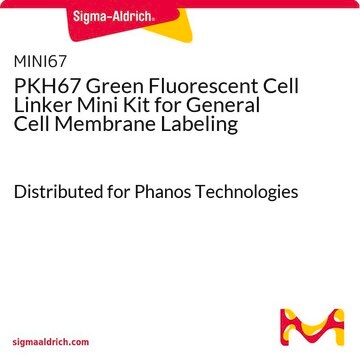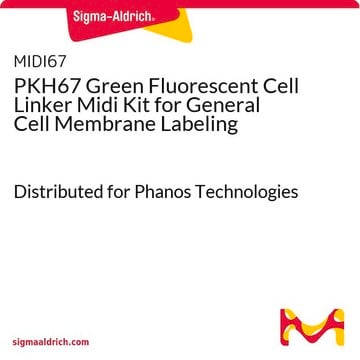Yes, Product PKH67 would be suitable for this application. In this paper, both Products PKH26 and PKH67 are used in a similar application:
https://www.ncbi.nlm.nih.gov/pmc/articles/PMC5679712/
PKH67GL
Kit linker cellulare PKH67 fluorescente verde per la marcatura generale della membrana cellulare
Distributed for Phanos Technologies
Sinonimo/i:
Green PKH membrane labeling kit
Scegli un formato
1.750,00 €
Scegli un formato
About This Item
1.750,00 €
Prodotti consigliati
Livello qualitativo
Confezionamento
pkg of 1 kit
Condizioni di stoccaggio
protect from light
Fluorescenza
λex 490 nm; λem 502 nm (PKH67 dye)
Metodo di rivelazione
fluorometric
Condizioni di spedizione
ambient
Temperatura di conservazione
room temp
Applicazioni
- per marcare e quindi studiare gli esosomi espulsi dalle cellule nel cancro della mammella triplo negativo[1]
- per marcare le cellule apoptotiche[2] al fine di studiare il ruolo del recettore ανβ5 nel legame e nell′internalizzazione delle cellule apoptotiche[3]
- nell′imaging in fluorescenza.[4]
È stata osservata una lenta perdita di fluorescenza negli studi condotti in vivo con PKH1 e PKH2. Il PKH67 può mostrare proprietà simili dal momento che questo comportamento sembra essere caratteristico dei coloranti linker cellulari verdi ma non di quelli rossi. La correlazione tra la ritenzione della membrana cellulare in vitro e l′emivita della fluorescenza in vivo nelle cellule che non si dividono prevede un′emivita della fluorescenza in vivo di 10-12 giorni per il PKH67. Altri coloranti linker cellulari con emivite analoghe sono stati utilizzati per monitorare il traffico di linfociti e macrofagi in vivo nell′arco di 1-2 mesi. Questo suggerisce che il PKH67 potrebbe essere utile anche per gli studi di tracking in vivo di durata moderata.
Linkage
Note legali
Solo come componenti del kit
- Diluent C 6 x 10
- PKH67 Cell Linker in ethanol .5 mL
Prodotti correlati
Avvertenze
Danger
Indicazioni di pericolo
Consigli di prudenza
Classi di pericolo
Eye Irrit. 2 - Flam. Liq. 2
Codice della classe di stoccaggio
3 - Flammable liquids
Punto d’infiammabilità (°F)
57.2 °F - closed cup
Punto d’infiammabilità (°C)
14 °C - closed cup
Scegli una delle versioni più recenti:
Possiedi già questo prodotto?
I documenti relativi ai prodotti acquistati recentemente sono disponibili nell’Archivio dei documenti.
I clienti hanno visto anche
Articoli
PKH dyes are easy to use and achieve stable, uniform, and reproducible fluorescent labeling of live cells. PKH dyes are non-toxic membrane stains which produce high signal to noise ratio.
Lipophilic cell tracking dyes enable cancer biologists to track tumor and immune cell functions both in vitro and in vivo. Read the article to choose a right membrane dye kit for cell tracking and proliferation monitoring.
Optimal staining is a key component for studying tumorigenesis and progression. Learn useful tips and techniques for dye applications, including examples from recent studies.
PKH and CellVue® Fluorescent Cell Linker Kits provide fluorescent labeling of live cells over an extended period of time, with no apparent toxic effects.
-
I mark mitochondria for injection with PKH26 Red Fluorescent Cell Linker Kit for General Cell Membrane Labeling. I want to use another dye to mark another type of mitochondria and inject them together in the same fish egg. Is PKH67 ok for this like PKH26?
1 risposta-
Utile?
-
-
What can be the alternative for removing excess dye after labeling of exosomes using PKH67 dye apart from ultracentrifugation?
1 risposta-
Excess dye is bound to serum or albumin which is added to the cell/dye mixture as a stop reaction. The recommended clean up or dye removal is by standard centrifugation (400 x g for 10 minutes, wash, and repeat). See the Product Information Sheet, page 3, bullet point 8 for more information:
https://www.sigmaaldrich.com/deepweb/assets/sigmaaldrich/product/documents/984/984/pkh67glbul.pdfAlternate methods for excess dye removal have not been investigated.
Utile?
-
-
Can we remove the excess PKH67 DYE used for the labeling of exosomes using exosome spin column rather than ultracentrifugation.
1 risposta-
The recommended exosome labeling protocol has been optimized to assure the best possible results. The use of exosome spin columns with the PKH and CellVue products has not been validated. See below for a link to our exosome labeling protocol. A spin column method may not offer the best results.
Utile?
-
-
Will Product PKH67, Green Fluorescent Cell Linker Kit, stain dead cells?
1 risposta-
As long as the cell has an intact membrane, the PKH76 dye can label the cell.
Utile?
-
-
What is the difference between Green Fluorescent Cell Linker Kits PKH2 and PKH67?
1 risposta-
PKH2 was one of the early PKH dyes. The PKH67 dye has a longer aliphatic tail. There is reduced cell-celldye transfer for PKH67 as compared with PKH2.
Utile?
-
-
What method of fixation can be used for tissue/cells with the PKH Fluorescent Cell Linker Kit for General Cell Membrane Labeling dyes?
1 risposta-
A protocol for visualization of tissue sections can be found in the technical bulletin. For visualization of stained cells by immunofluorescence or flow cytometry, the cells can be fixed in 2% paraformaldehyde for 15 minutes. The use of other organic solvents will extract the dye from the cells. If internal labeling is desired, the cells can be permeabilized with saponin (50-75 μg/mL). Here is the link to the Troubleshooting Guide.
Utile?
-
-
What is the Department of Transportation shipping information for this product?
1 risposta-
Transportation information can be found in Section 14 of the product's (M)SDS.To access the shipping information for this material, use the link on the product detail page for the product.
Utile?
-
-
What is the excitation and emission spectra for Product PKH67GL, Green Fluorescent Cell Linker Kit?
1 risposta-
The spectra can be found on the product insert.The product has a maximum excitation at 490 nm and maximum emission at 502 nm.
Utile?
-
-
How many cells can be stained with Product PKH67GL, Green Fluorescent Cell Linker Kit?
1 risposta-
This kit can stain 50 × 107 cells if used as directed (1 × 107 cells stained with 2 × 10-6 M PKH67).
Utile?
-
-
When using Product PKH67GL, PKH67 Green Fluorescent Cell Linker Kit for General Cell Membrane Labeling, how long will the cells remain stained after treatment?
1 risposta-
Labeled cells that have been washed can be visualized in culture up to 100 days after staining (for non-dividing cells). The dye itself is stable and will divide equally when the cells divide. After staining with PKH dyes, you can observe as many as 8 divisions depending on how brightly the cells were stained initially and the amount of surface area on the cells. Most commonly, 4-6 divisions can be visualized.
Utile?
-
Filtri attivi
Il team dei nostri ricercatori vanta grande esperienza in tutte le aree della ricerca quali Life Science, scienza dei materiali, sintesi chimica, cromatografia, discipline analitiche, ecc..
Contatta l'Assistenza Tecnica.














